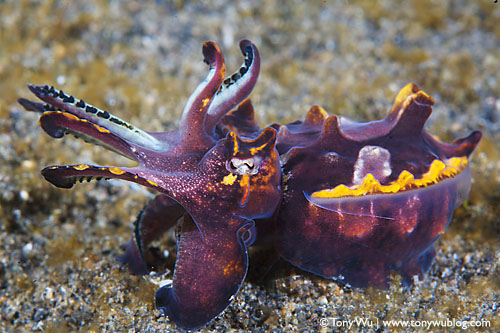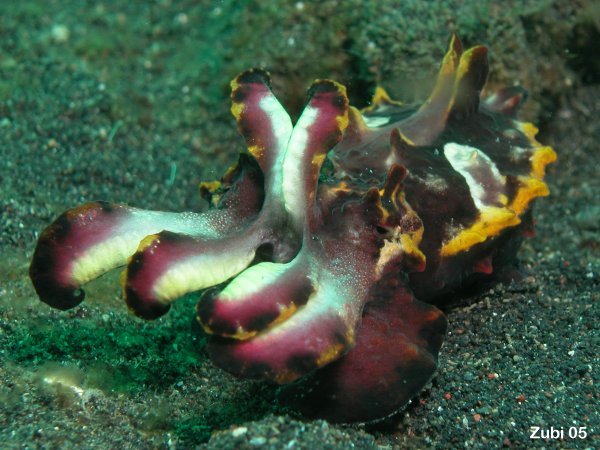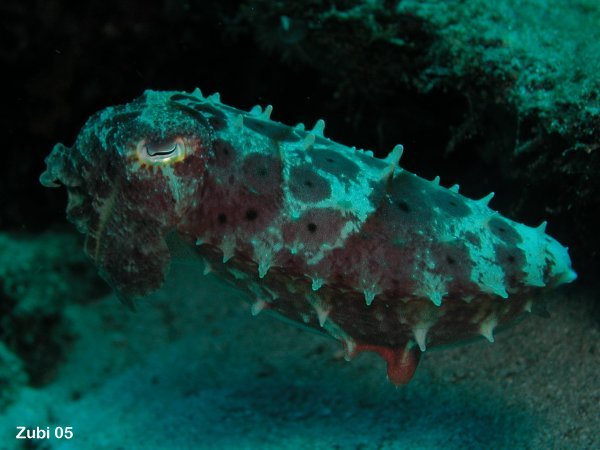Cuttlefishhttp://en.wikipedia.org/wiki/CuttlefishCuttlefish are marine animals of the order Sepiida belonging to the Cephalopoda class (which also includes squid, octopuses, and nautiluses). Despite their common name, cuttlefish are not fish but molluscs. Recent studies indicate that cuttlefish are among the most intelligent invertebrate species.
The origin of the word cuttlefish can be found in the old English term cudele, itself derived in the 1400s from the Norwegian koddi (testicle) and the Middle German kudel (pouch), a literal description of the cephalopod's shape. The Greco-Roman world valued the cephalopod as a source of the unique brown pigment released from its siphon when alarmed. Hence, the word for it in Greek and Latin is sepia (later seppia in Italian).
Cuttlefish have an internal shell (cuttlebone), large W-shaped pupils, and eight arms and two tentacles furnished with denticulated suckers, with which they secure their prey.
Cuttlefish eat small molluscs, crabs, shrimp, fish and other cuttlefish. Their predators include dolphins, sharks, fish, seals and other cuttlefish. Their life expectancy is about one to two years.
Changing color
Cuttlefish are photochromic, and are sometimes referred to as the chameleon of the sea because of their remarkable ability to rapidly alter their skin color at will. Their skin flashes a fast-changing pattern as communication to other cuttlefish and to camouflage them from predators. This color-changing function is produced by groups of red, yellow, brown, and black pigmented chromatophores above a layer of reflective iridophores and leucophores, with up to 200 of these specialized pigment cells per square millimeter. The pigmented chromatophores have a sac of pigment and a large membrane that is folded when retracted. There are 6-20 small muscle cells on the sides which can contract to squash the elastic sac into a disc against the skin. Yellow chromatophores (xanthophores) are closest to the surface of the skin, red and orange are below (erythrophores), and brown or black are just above the iridophore layer (melanophores). The iridophores reflect blue and green light. Iridophores are plates of chitin or protein, which can reflect the environment around a cuttlefish. They are responsible for the metallic blues, greens, golds, and silvers often seen on cuttlefish. All of these cells can be used in combinations. For example, orange is produced by red and yellow chromatophores, while purple can be created by a red chromatophore and an iridophore. The cuttlefish can also use an iridophore and a yellow chromatophore to produce a brighter green. As well as being able to influence the color of the light that reflects off their skin, cuttlefish can also affect the light's polarization, which can be used to signal to other marine animals, many of which can also sense polarization.
Blood
The blood of a cuttlefish is an unusual shade of green-blue because it uses the copper-containing protein hemocyanin to carry oxygen instead of the red iron-containing protein hemoglobin that is found in mammals. The blood is pumped by three separate hearts, two of which are used for pumping blood to the cuttlefish's pair of gills (one heart for each gill), and the third for pumping blood around the rest of the body. A cuttlefish's heart must pump a higher blood flow than most other animals because hemocyanin is substantially less capable of carrying oxygen than hemoglobin.
Flamboyant Cuttlefish


Broadclub Cuttlefish


 Author
Topic: Amazing nature (Read 69479 times)
Author
Topic: Amazing nature (Read 69479 times)
